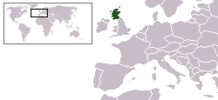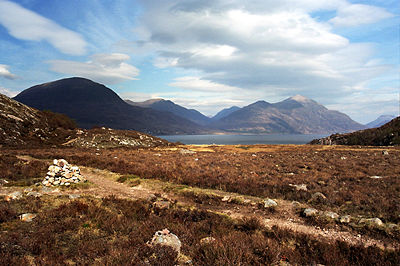Portal:Scotland
2008/9 Schools Wikipedia Selection. Related subjects: Countries; Geography of Great Britain; Portals
|
Scotland ( Gaelic: Alba) is a country that occupies the northern third of the island of Great Britain. It is part of the United Kingdom, and shares a land border to the south with England. It has a population of 5,117,000 and an area of 78,800 km². Scotland shares a 60 mile (96 km) land border to the south with England, and is bounded by the North Sea to the east, the Atlantic Ocean to the north and west, and the North Channel and Irish Sea to the south-west. Scottish waters border those of Norway, the Faeroes, Iceland and Ireland. Apart from the mainland, Scotland consists of over 790 islands, giving it a coastline of approximately 6200 miles (9,900 km). The Kingdom of Scotland was united in 843, by Kenneth MacAlpin, King of Scots, and is thus one of the oldest still-existing countries in the world. Scotland existed as an independent state until the Act of Union, 1 May 1707. The flag of Scotland - the Saltire or St Andrew's Cross - is thought to be the oldest national flag still in use. Saint Andrew is the patron saint of Scotland and Saint Andrew's Day, on 30 November, is Scotland's national day. There are currently attempts to create a national holiday on this day. Scottish people have played prominent parts in many important inventions and discoveries. Harris Tweed (Clò Mór or Clò na Hearadh in Gaelic), is a luxury cloth that has been handwoven by the islanders on the Isles of Harris, Lewis, Uist and Barra in the Outer Hebrides of Scotland, using local wool. Traditional Harris Tweed was characterized by subtle flecks of colour achieved through the use of vegetable dyes, including the lichen dyes called "crottle" ( Parmelia saxatilis and Parmelia omphalodes which give deep red- or purple-brown and rusty orange respectively). These lichens are the origin of the distinctive scent of older Harris Tweed. The original name of the cloth was tweel, the Scots for twill, the cloth being woven in a twilled rather than a plain pattern. A traditional story has the current name coming about almost by chance. About 1830, a London merchant received a letter from a Hawick firm about some tweels. The London merchant misinterpreted the handwriting understanding it to be a trade-name taken from the name of the river Tweed which flows through the Scottish Borders textile areas, subsequently the goods were advertised as Tweed, the name has remained so ever since. With the initiation of the industrial revolution the Scottish mainland turned to mechanisation, but the Outer Hebrides retained their traditional processes of manufacturing cloth. Until the middle of the 19th century the cloth was only produced for personal use within the local market. It was not until between 1903 and 1906 that the tweed-making industry in Lewis significantly expanded. Production increased until the peak figure of 7.6 million yards was reached in 1966. The Torridon Hills surround Torridon village in the Northwest Highlands of Scotland. The name is usually applied to the mountains to the north of Glen Torridon. These are all made of a type of sandstone, known as Torridonian sandstone (see Geology of the United Kingdom), which over time has become eroded to produce the unique characteristics of the Torridon hills.
|
||||||||||||





